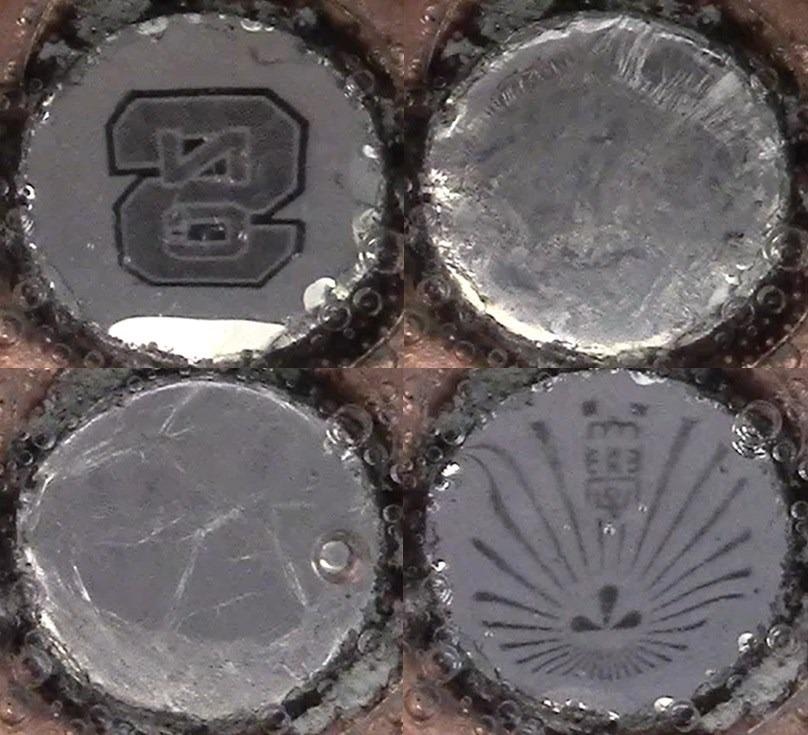Jun 15 2021
Scientists have developed a new method to dynamically change the liquid metal surface between reflecting and scattering states. This technique could be used for making illumination devices or electrically controlled mirrors in the future.
 Researchers have developed a way to dynamically switch the surface of liquid metal between reflective (top left and bottom right) and scattering states (top right and bottom left). When electricity is applied, a reversible chemical reaction oxidizes the liquid metal, creating scratches that make the metal scattering. Image Credit: Keisuke Nakakubo, Kyushu University.
Researchers have developed a way to dynamically switch the surface of liquid metal between reflective (top left and bottom right) and scattering states (top right and bottom left). When electricity is applied, a reversible chemical reaction oxidizes the liquid metal, creating scratches that make the metal scattering. Image Credit: Keisuke Nakakubo, Kyushu University.
Liquid metals typically integrate the electrical, optical and thermal characteristics with the fluidity of a liquid. The novel method creates switchable reflective surfaces on a liquid metal by using an electrically driven chemical process. The liquid metal can be made highly reflective without using optical coatings or polishing stages, which are often needed to create reflective optical components.
A research team, headed by Yuji Oki from Kyushu University in Japan, has described how the switching mechanism between reflective and scattering states can be accomplished with just 1.4 V, which is roughly the same voltage needed to light a standard LED. The study has been published in the Optical Society (OSA) journal, Optical Materials Express.
The researchers worked with Michael D. Dickey’s research team from North Carolina State University to devise the new approach, which can be used at room temperatures and pressures.
In the immediate future this technology could be used to create tools for entertainment and artistic expression that have never been available before. With more development, it might be possible to expand this technology into something that works much like 3D printing for producing electronically controlled optics made of liquid metals.
Yuji Oki, Kyushu University, Japan
“This could allow the optics used in light-based health testing devices to be easily and inexpensively fabricated in areas of the world that lack medical laboratory facilities,” added Oki.
Creating an Optical Surface
In their latest study, the researchers used an embedded flow channel to create a reservoir. Then, using a ‘push-pull approach,” they created optical surfaces by either pushing gallium-based liquid metal into or pulling it out of a reservoir. This method resulted in the formation of concave, flat, or convex surfaces, with each having different optical characteristics.
The researchers then applied electricity to start a chemical process that oxidizes the liquid metal in a reversible manner. This oxidation alters the volume of the liquid in such a way that creates many tiny scratches on the surface which then lead to the scattering of light.
The liquid metal returns to its original condition when voltage is applied in the reverse direction. The surface tension of the liquid metal causes the scratches to vanish and restores the surface to a clean reflecting mirror condition.
The new technology was discovered by chance while the researchers were working with a liquid metal to see whether it could be used to create molds for use with a silicone elastomer.
Our intention was to use oxidation to change the surface tension and reinforce the surface of the liquid metal. However, we found that, under certain conditions, the surface would spontaneously change into a scattering surface. Instead of considering this a failure, we optimized the conditions and verified the phenomenon.
Yuji Oki, Kyushu University, Japan
Characterizing the Phenomenon
The different surfaces generated by applying electricity were optically and electrochemically characterized by the researchers. The team observed that adjusting the surface voltage from −800 to +800 mV reduced the intensity of light as the surface switched from the reflecting to scattering states. The electrochemical measurements demonstrated that a voltage difference of 1.4 V was enough to produce redox reactions with excellent reproducibility.
We also found that under certain conditions the surface can be slightly oxidized and still maintain a smooth reflective surface. By controlling this, it might be possible to create even more diverse optical surfaces using this approach that could lead to applications in advanced devices such as biochemical chips or be used to make 3D printed optical elements.
Yuji Oki, Kyushu University, Japan
Journal Reference:
Nakakubo, K., et al. (2021) Dynamic control of reflective/diffusive optical surfaces on EGaIn liquid metal. Optical Materials Express. doi.org/10.1364/OME.425432.